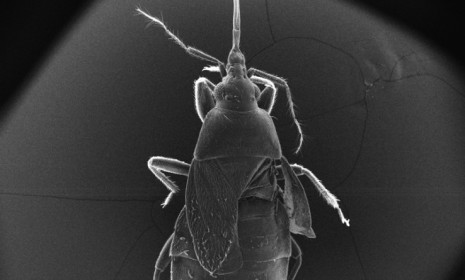The violent sex life of the 'dagger penis' bug
Rather than mate through traditional means, Xylocoris flavipes uses its razor-sharp private parts to brutally impregnate females

Some insects — like the female praying mantis — are known to devour puny male partners soon after mating. But that seems almost tame compared to the violent copulation techniques employed by Xylocoris flavipes, more commonly known as the warehouse pirate bug. A male on the prowl comes equipped with a spiny "dagger penis," which the bug uses to forcibly stab its way into a female's abdomen, ejaculating once inside. Now, a new Swedish study has shed more light on the ramifications of this unusual reproduction technique. Here, a brief guide to the six-legged critter's scary mating ritual:
What is a warehouse pirate bug?
It's a tiny 3mm beetle often used by humans to guard grain storage warehouses. Because it eats moth and beetle larvae, the warehouse pirate bug prevents other insects from feasting on supplies of dried grains, nuts, and corn (which the pirate bug doesn't eat). Males, however, have been known to force themselves on potential mates, and researchers at Umeå University in Sweden recently decided to find out more.
The Week
Escape your echo chamber. Get the facts behind the news, plus analysis from multiple perspectives.

Sign up for The Week's Free Newsletters
From our morning news briefing to a weekly Good News Newsletter, get the best of The Week delivered directly to your inbox.
From our morning news briefing to a weekly Good News Newsletter, get the best of The Week delivered directly to your inbox.
What exactly happens when they have sex?
Instead of copulating through traditional methods, male pirate bugs use their razor-sharp private parts to pierce the female through her exoskeleton shell and ejaculate inside. Scientists call this method "traumatic insemination." It leaves "gaping, seeping wounds in the female," says Jennifer Welsh at LiveScience.
How awful. Why do they do this?
Mostly because it seems to work, says Welsh. In a series of observational experiments, Swedish scientists discovered that wounded females, vulnerable to multiple male partners, lay a whole lot of eggs, but die at a very young age. Researchers think this could be a response to the stab wounds: Female bugs may be "injured from the dagger penises and worried about dying," so their evolutionary inclination is to reproduce faster.
A free daily email with the biggest news stories of the day – and the best features from TheWeek.com
And this is good for pirate bugs?
Counterintuitively, yes... at least in terms of population growth. From an evolutionary standpoint, the gruesome technique seems to have worked, "due to the increased reproductive success of males that employed it," says Science 2.0. And though traumatic insemination is costly to female bugs, they're not completely helpless. In fact, scientists have identified "unique counter adaptations" in their physiology, including the evolution of "completely new organs" to help ward off infection from traumatic insemination.
Sources: LiveScience, MSN, Science 2.0, USDA.gov
-
 Tea with Judi Dench: ‘touching’ show is must-watch Christmas TV
Tea with Judi Dench: ‘touching’ show is must-watch Christmas TVThe Week Recommends The national treasure sits down with Kenneth Branagh at her country home for a heartwarming ‘natter’
-
 Codeword: December 24, 2025
Codeword: December 24, 2025The daily codeword puzzle from The Week
-
 Sudoku hard: December 24, 2025
Sudoku hard: December 24, 2025The daily hard sudoku puzzle from The Week